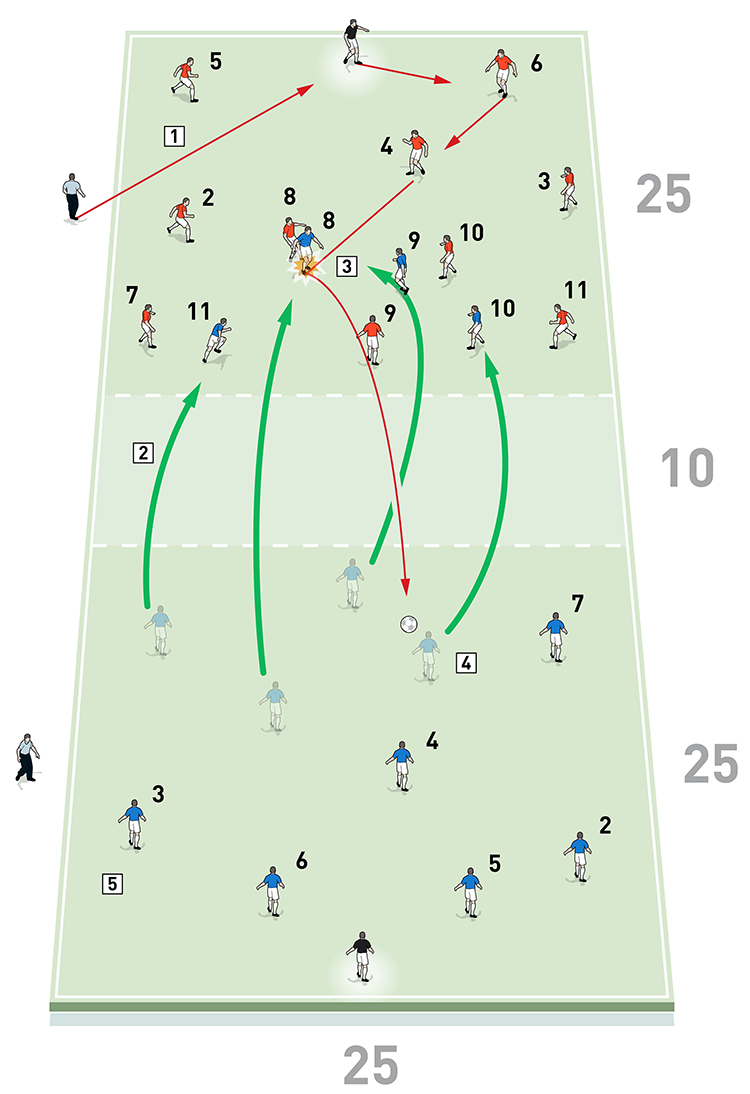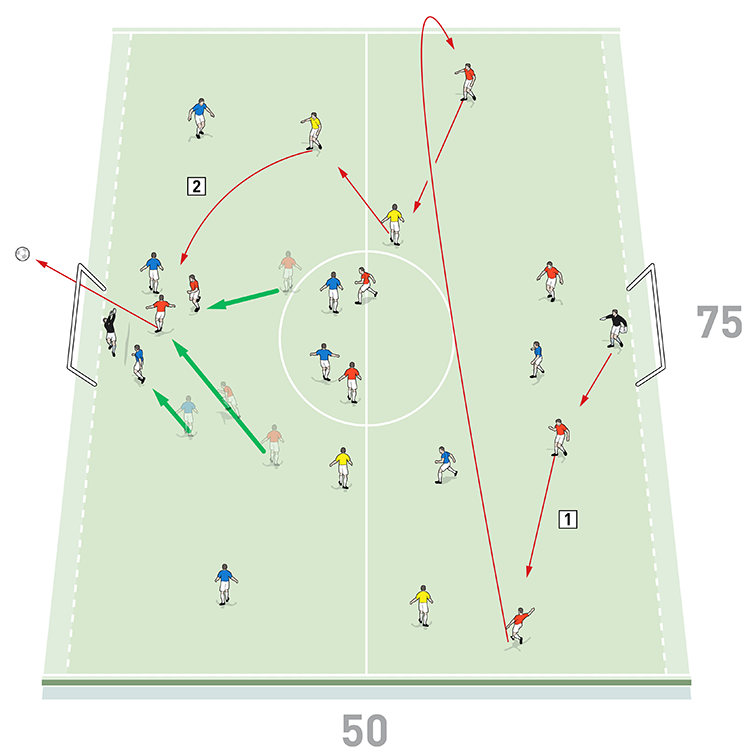You are viewing 1 of your 1 free articles
Possession drills with players in position
The aim of the session is for players to try and keep possession in order to dominate the game. It’s also designed to encourage players to play one-touch or two-touch football. It will improve passing in tight areas and will help to encourage quick decision making when players are closed down in tight spaces.
| Area | Up to half a pitch + full pitch for 11v11 game |
| Equipment | Balls, bibs, cones, 2 goals |
| No. of Players | 20 players + 2 goalkeepers + 2 servers |
| Session Time |
Practice 1: 15mins, Practice 2: 15mins, Practice 3: 15mins, 11v11 game: 25mins |
The aim of the session is for players to try and keep possession in order to dominate the game. It’s also designed to encourage players to play one-touch or two-touch football. It will improve passing in tight areas and will help to encourage quick decision making when players are closed down in tight spaces.
I like using this session because it is realistic to a match day. These activities will really motivate players as they are all performed at a high intensity and the players get plenty of touches of the ball.
We usually use this session, or parts of it, twice a week depending on whether or not we have a midweek game.
PRACTICE 1
We set up two boxes of 25x25 yards separated by a 10-yard central channel. We’re using 20 outfield players and two goalkeepers, plus two servers who pass into the possession team. We play a 4v4 in each box, with three floaters in each. Players should play in their normal positions where possible and the floaters should stay in position, with one a goalkeeper, one a midfielder and one a striker.
The possession team links with the three floaters to make it a 7v4 in each box, as shown [1]. The possession team needs to make 12 consecutive passes to score a point. If the pressing team wins the ball, they become the new possession team and should pass the ball with the help of the floaters.
1

2. In each box three floaters play for the team in possession. They should stay in position: one is a goalkeeper, one is a midfielder and one is a striker
3. The possession team links with the neutral floaters to make it 7v4 in each box
4. The possession team needs to make 12 consecutive passes to score a point
5. If the pressing team wins the ball, they become the new possession team
We play four games of three minutes each, with one minute’s rest in between.
PRACTICE 2
We use the same basic set up as before but this time the 11 players in each box are from the same team and are in their team shape. A server starts and restarts play with a pass to the goalkeeper and that team must pass to keep possession. The other team sends four players across the 10-yard channel and into the opposition’s box where they must try to win the ball by working in groups to press the possession team.
If the four pressing players win the ball they can either pass to their team mates in the other box, as shown [2], or kick it out of play. If they manage to pass it back to their own box, they must follow the ball and with their team mates they must pass to keep possession away from the four opposition pressers who have followed them into their box.
2

2. The other team sends four players across the 10-yard channel into the possession box where they try to win the ball by working in groups to press
3. If the four pressing players win the ball they can either pass to their team mates in the other box, as here, or kick it out of play
4. If the blue pressers manage to pass it back to their own box, they follow the ball and play continues in the same manner with the blues now passing to keep possession
5. The first team to complete a target number of passes wins the game, but the passes do not need to be consecutive
Play is one-touch and the coach should keep count of the number of passes each team makes. The first team to complete a target number of passes (50, 60 or 70 passes) wins the game, but the passes do not need to be consecutive. When a team loses possession, they will start again at the same number of passes when they regain possession.
PRACTICE 3
We set up a playing area of approximately 50x75 yards (the area is 50 yards long and the full width of the pitch) with a goal and a goalkeeper at each end. We’re using 20 outfield players split to two teams of eight and four floaters.
We play a normal 8v8 game with players set up in their team shape and with the floaters playing for the team in possession. This means the attacking team will be playing with a 12v8 overload, as shown [3].
3

2. The four yellow floaters play for the team in possession, giving the attacking team a 12v8 overload
The only condition is that players are limited to two touches. We play three games of five minutes.
How would I put this in a game situation?
We would usually finish this session by progressing into an 11v11 game on a full pitch. We would play this for 25 minutes.
What are the key things to look out for?
Technically, we want to see players able to keep possession and demonstrating good ball control
in tight spaces.
Tactically, we want to see players understanding that they should function in their normal positions and make effective transitions from defence to attack. We also want to see players making good decisions.
What are the typical mistakes players might make and how do I avoid them?
Typical mistakes might be that players will fail to read the situation quickly enough and that they use incorrect body positions when receiving the ball.
Related Files
Editor's Picks
Using the goalkeeper in build-up play
Pressing principles
Intensive boxes drill with goals
Penetrating the final third
Creating and finishing
My philosophy
Pressing initiation
Compact team movement
Defensive organisation
Coaches' Testimonials

Alan Pardew

Arsène Wenger

Brendan Rodgers

Carlos Carvalhal

José Mourinho

Jürgen Klopp

Pep Guardiola

Roy Hodgson

Sir Alex Ferguson

Steven Gerrard
Coaches' Testimonials

Gerald Kearney, Downtown Las Vegas Soccer Club

Paul Butler, Florida, USA

Rick Shields, Springboro, USA

Tony Green, Pierrefonds Titans, Quebec, Canada
Join the world's leading coaches and managers and discover for yourself one of the best kept secrets in coaching. No other training tool on the planet is written or read by the calibre of names you’ll find in Elite Soccer.
In a recent survey 92% of subscribers said Elite Soccer makes them more confident, 89% said it makes them a more effective coach and 91% said it makes them more inspired.
Get Monthly Inspiration
All the latest techniques and approaches
Since 2010 Elite Soccer has given subscribers exclusive insight into the training ground practices of the world’s best coaches. Published in partnership with the League Managers Association we have unparalleled access to the leading lights in the English leagues, as well as a host of international managers.
Elite Soccer exclusively features sessions written by the coaches themselves. There are no observed sessions and no sessions “in the style of”, just first-hand advice delivered direct to you from the coach.









